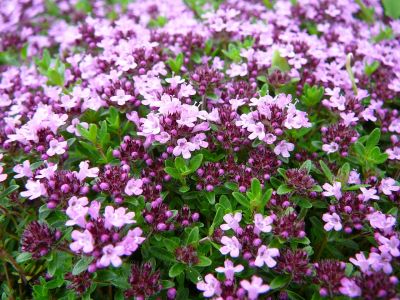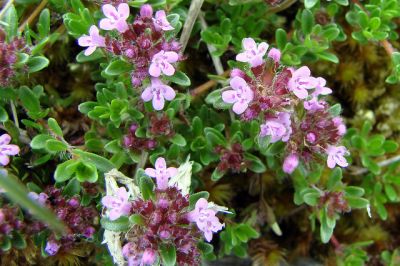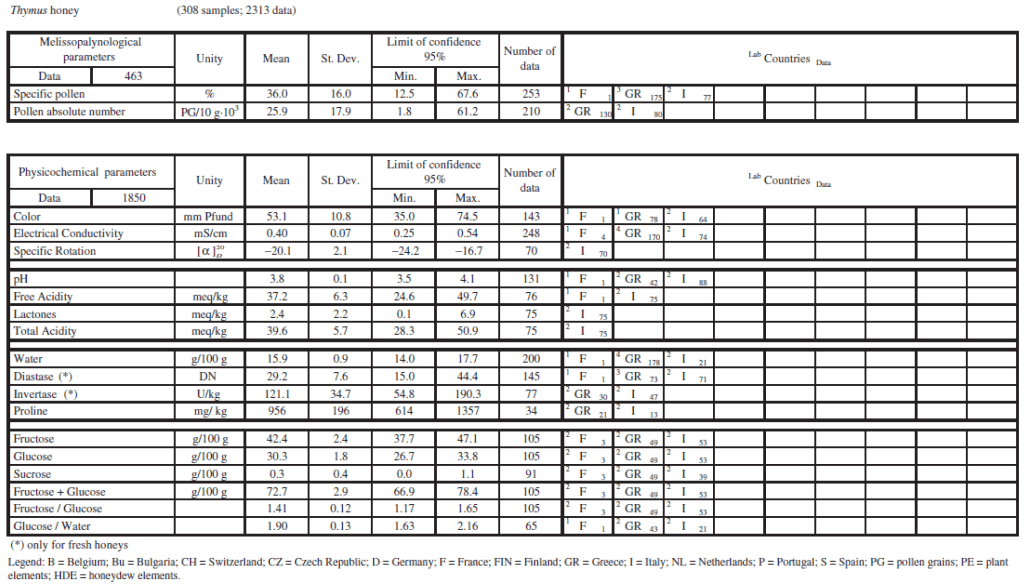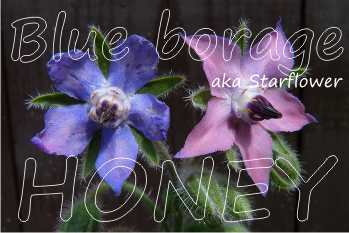As the name says, thyme honey is produced from thyme. We all know it because of its culinary, medicinal and ornamental uses. But where there are large cultures of a medicinal plant, an amazing honey can be produced. And thyme honey is one great product with many health benefits.
What is thyme?
Thyme is a member of the nectar-producing mint family, Lamiaceae, the source of other flavorful honeys such as mint, sage, oregano, and lavender.
It is best cultivated in a hot, sunny location with well-drained soil. It is generally planted in the spring, and thereafter grows as a perennial. It can be propagated by seed, cuttings, or by dividing rooted sections of the plant. It tolerates drought well. The plants can take deep freezes and are found growing wild on mountain highlands.
Thyme belongs to the genus Thymus, which contains about 350 species of aromatic perennial herbaceous plants and subshrubs. Among them: Thymus citriodorus: various lemon thymes, orange thymes, lime thyme; Thymus herba-barona (caraway thyme), used both as a culinary herb and a ground cover, and has a very strong caraway scent due to the chemical carvone; Thymus praecox (mother of thyme, wild thyme), cultivated as an ornamental; Thymus pseudolanuginosus (woolly thyme) which is not a culinary herb, but is grown as a ground cover.
And there are some species which constitute an important nectar source for honey bees.
- Thymus serpyllum (wild thyme, creeping thyme, Mother-of-Thyme) Of course all thyme species are nectar sources, but wild thyme covers large areas of droughty, rocky soils in southern Europe (Both Greece and Malta are especially famous for wild thyme honey) and North Africa, as well as in similar landscapes in the Berkshire and Catskill Mountains of the northeastern US.

- Thymus vulgaris (aka garden thyme, common thyme, English thyme, summer thyme, winter thyme, French thyme,) is a Mediterranean perennial which is best suited to well-drained soils and full sun. It is a commonly used culinary herb. Also with medicinal uses. It makes an very healthy honey.

- Wild Thyme (T. Capitatus) a compact, woody perennial native to Mediterranean Europe and Turkey. It has pink, 10 mm (0.39 in)-long flowers, held in cone-shaped clusters at the ends of their stems. Wild thyme is found wild in dry, rocky Mediterranean regions, but is also cultivated for the essential oil (in Spain, France, Switzerland).

How is the thyme honey?
General characteristics of thyme honey:
– The honey is produced between the second half of June and the first half of July.
-The color of thyme honey is light amber to amber when liquid, beige to brown when it is crystallized.
-it is a very strong, intensely aromatic honey with resinous, herbal, savory flavors; fresh and reminiscent of tropical fruits, dates and white pepper.
– The taste is persistent, lingering in the mouth.
– It crystallizes spontaneously in a short time into medium or fine grains.
– It has an intense and complex aroma, which has been described as; floral, spicy, dried flowers, magnolia flowers, cedar, herbs, flowers, rubbed, clove, burnt plastic, pencil drawing, mulled wine, and Marsala.
– The flavor has been described as: salty, thymol, pharmacy, plastic, pencil, dates and pepper.
Unifloral thyme honey presents quite high values of diastase, high values of proline, fructose and acidity (causing a quick increase in HMF); the specific rotation has the lowest values.
Unifloral Thyme honey is mainly produced in:
Italy from Thymus capitatus (pollen grains/10 g: 10 100 ± 6 000; Thymus pollen 26.6% ± 10.0);
Greece from a variety of different species of Thymus and other Labiatae. The Greek samples show a very variable pollen content (pollengrains/10 g:33 800 ± 16 700; Thymus pollen 40.2% ± 16.4);
Spain and France mainly from Thymus vulgaris;
New Zealand from Thymus vulgaris
in 2023, Greek thyme honey won the Gold Award at Dubai Taste Awards. The winning brands were:
– Akiraton Greek Thyme Honey Naxos produced by Akiraton.
– Anoteron Honey, by Anoteron Honey
 Italian thyme honey
Italian thyme honey
It comes mostly from Thymus capitatus. Here is a sensory description of it:
– Colour intensity: medium to dark
– Intensity of odour: medium
– Description: woody, chemical, fresh and floral – fresh fruit (floral)
– Sweetness: medium
– Bitterness: absent
– Acidity: medium
– Crystallisation rate: moderate
According to “Main European unifloral honeys: descriptive sheets” by Livia PERSANO ODDO, Roberto PIRO and all, 2004, and published by Apidologie.org, 35 (2004) S38–S81© INRA/DIB-AGIB/ EDP Sciences, 2004, here are the values of the main components of this type of thyme honey:
From the famous Italian thyme honey we can mention:
– the Sicilian Mount Iblei Thyme honey or the Hyblaean Honey, with an ancient reputation. In Sicily there is a a honey festival called Sagre del Miele, on the first Sunday in October. It is an important event for a core product of the Sortinese economy.
This honey is not actually an unifloral honey, but a mixture of different nectars, called “satru”, with a characteristic flavor of wild thyme (Thymus capitatus).
– the Sardinian & Corsican Thyme honey, which is a different type of honey made of both T. capitus and T. herba-barona (caraway thyme). When liquid, Herba-barona honey is dense and its color varies between light amber and amber. When crystallized, it is darker in color, with medium sized, aggregated and rough crystals.
While sharing many of the aromatic and flavor characteristics of other Thyme honeys, it has a unique taste and flavor. Having a medium intensity, the aroma is floral and spicy with hints of thymol, dried flowers, Magnolia, aromatic herbs, clover, burnt plastic, drawing pencil, Marsala and cooked wine. The taste is sweet and slightly acidic, with a persistant spicy component.
Greek thyme honey
Greek thyme honey is light coloured and, infused with layers of flavour from the abundant wild flowers carpeting the mountains in spring and summer. The presence of phenol is known for its antibacterial activity (Greek Thyme Honey, 2013).
– The most important part of producing thyme honey in Greece is from the slopes of Mount Hymettus (in Attica near Athens), from wild thyme (T. Capitatus) and thyme-leaved savory (Satureia thymbra).
Mount Hymettus is known locally as “Trelos” or “Crazy” (τρελός), and people believe this is due to the wild and crazy behavior of the bees, when eating thyme pollen and nectar. Other people think it describes the unstable weather that hovered over the mountain, and others believe it is a corruption of the 15th century French, “Tres Long” (Too long). The true origin has been lost in the annals of “Thyme”, yet Hymettus honey is loved now as it has been for thousands of years and is still enjoyed by the people of Athens and throughout Greece.

– Thyme is one of the most common phrygana shrubs in Crete and is found in dry locations, phrygana and stony locations. It grows from sea level to an altitude of 2000 metres. See some amazing photos with thyme from Crete here: west-crete.com.
Because thyme grows wild it is organic, although there are no certification standards in place. The percentage of thyme nectar by pollen count averages around 40% and ranges from the high teens to 90%. It is commonly mixed with other Lamiaceae species such as Sage, Oregano, Rosemary and Savory.
A popular way to eat Thyme honey in Greece is drizzled over fresh Greek yogurt (known as “Yiaourti me Meli”: γιαούρτι με μέλι), with a few nuts on top of eat. Also believed to increase potency. Natural viagra” – they say!
New Zealand Thyme honey:
The thyme honey here is produced from Garden thyme or Common Thyme (T. vulgaris)
In New Zealand there is Alexandra Thyme Festival, which celebrates the beauty of the Central Otago landscape in November when the wild thyme blooms and the fine thyme honey. The festival evolved into a week celebrating the arts and sustainability with the theme of cherishing our environment.
Thyme honey health benefits
Thyme is very popular as a cooking herb, but it is also antiseptic, antimicrobial and anti-fungus. Its active ingredients the biocides, thymol and carvacro are extracted from the oil of thyme.
We find it in aromatherapy as oils. Ancient Egyptians used it to prepare mummies and it is still used in commercial mouth washes (Listerine) and cough medicines.
Because of its strong odor, it is also used as a pest repellent and mild insecticide.
A 2009 study “Bioactivity of Greek honey extracts on breast cancer (MCF-7), prostate cancer (PC-3) and endometrial cancer (Ishikawa) cells: Profile analysis of extracts.“, showed that thyme honey reduced the viability of endometrial (Ishikawa) and prostate (PC-3) cancer cells. These anticancer properties are due to its polyphenols, and phenolic acids.
The authors’ conclusion was that “thyme honey, may be used as an alternative to sugar, while its incorporation in the human diet or as a food ingredient may prevent cancer-related processes, promoting thus the health of consumers”.
For its excellent anti-bacterial and antifungal properties, it is used:
– as a poultice for wounds, to prevent infection, in Greece
– to cover burns and scalds
– to treat sore throats due to colds or flu.
Other types of honey:
Basswood – linden – lime honey
Mint Honey
Manuka honey
Lifemel honey
Ikaria honey
Sidr honey
Tualang honey
Mad honey
Sunflower honey
Clover honey
************************************
|
|
Picture credits:
Wild thyme by Joanna Paterson under CC via flickr.com;
Thymus serpyllum picture credit Kingsbrae Garden under CC via flickr.com;
Thymus vulgaris by Ferran Turmo Gort under CC via flickr.com
References:
honeytraveler.com;
Main European unifloral honeys: descriptive sheets,© INRA/DIB-AGIB/ EDP Sciences, 2004, apidologie.org;
wikipedia.org




